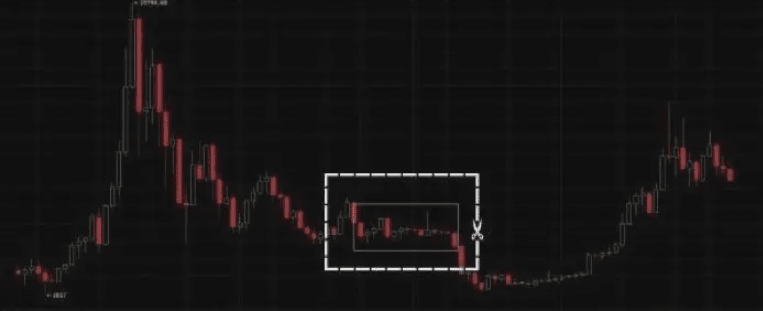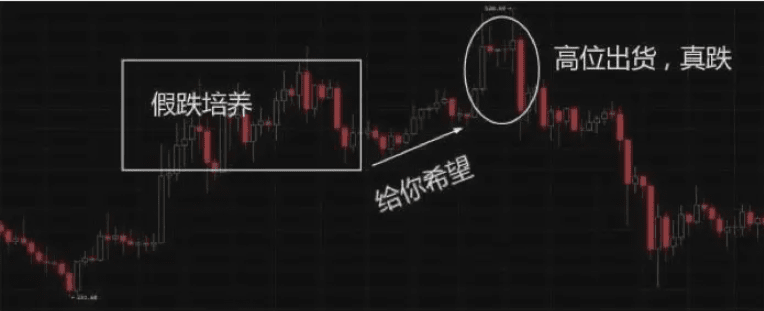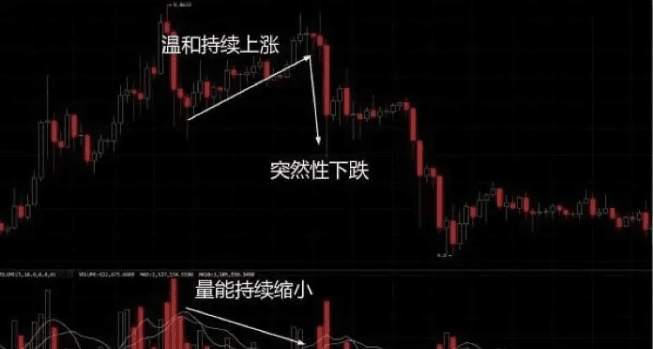In the digital currency market, market makers and retail investors are natural enemies. The reason is simple: market makers profit by harvesting retail investors, while retail investors seek to ride the market makers to harvest other retail investors or directly profit off the market makers. Unless this market disappears, the 'war' between market makers and retail investors will never end. To avoid being harvested and to make profits, it is crucial for retail investors to understand the techniques used by market makers.
Today, let's share a few of the most commonly used techniques by market makers for unloading stocks, to avoid becoming a high-position bag holder.

Market Maker Unloading Technique 1: High Position Oscillation Unloading
This technique, while common, is extremely deceptive. Simply put, it involves oscillating within a relatively high price range, misleading retail investors into thinking that the market will continue to rise after correcting. During this time, retail investors may choose to hold or buy, unaware that the market maker has unconsciously completed their unloading during the oscillation.
High-position oscillation unloading seeks discreetness, so the trading volume during the unloading process does not show significant increases; it generally remains relatively stable, and there may even be occasional decreases.

Market Maker Unloading Technique 2: High-Raising Unloading
This technique is very simple: it involves quickly raising the price and then rapidly unloading. It creates an illusion of a breakthrough rise for retail investors, deceiving them into chasing the price up, only to face a swift drop that catches them off guard, leaving no opportunity for stop-loss.
The performance state is generally: the coin price is quickly raised, followed by a large volume drop, with a significant decline.

Market Maker Unloading Technique 3: False Dip Unloading
This technique can be described as very insidious; if you're not careful, you can easily fall for the market maker's tricks. Simply put, it involves periodically creating false dips to deceive, then quickly pulling back, making everyone gradually accustomed to these rapid false dips. Once everyone is used to it, the market maker has already started unloading during this process. However, this unloading speed does not satisfy the market maker, so they will create real drops after unloading at high positions, leading retail investors to mistakenly believe it's just another false dip, making it difficult for them to escape in time. The performance technique involves frequent appearances of large bearish candles during certain periods, but the decline won't last long, generally followed by a pullback, repeating this pattern. Once everyone is accustomed to it, a small upward move may occur (or it may not), giving people hope, followed by a real drop when the high-position unloading occurs.

Market Maker Unloading Technique 4: Inducing More Buying Unloading
This typically occurs after a round of upward adjustment, where prices rise gently, and volume does not increase or even often decreases, leading investors to believe that the current position is not a top and continue holding or buying. Once it accumulates to a certain extent, the market maker will unload at high positions. The characteristics of K-lines show: price space is relatively high, price rises slowly, and there is gentle volume increase at high positions.

The above are the most common techniques used by market makers to unload stocks in the current market, though they are not exhaustive. Often, market makers will use multiple methods in conjunction, rather than relying on a single technique, so it is important to pay special attention to this point. These trading techniques may be less commonly used in mainstream cryptocurrencies, but are most evident in low-cap coins; those interested can take a closer look at the charts of small-cap coins.
In the cryptocurrency market, the three types of market makers, along with some typical project cases.
1. Independent Market Maker Representative Case: Most altcoins
As the name suggests, 'independent market maker' refers to a large player controlling a project and completing the entire process of accumulating, raising, and unloading a token. Under the independent market maker model, the price fluctuations of the coin almost entirely depend on the market maker's will, which can easily cause significant profit losses for investors. This is a key target for financial regulatory agencies, hence 'independent market making' usually only occurs in markets that are just starting out or lack regulation, such as the 1990s with the 'Lvliang Fleet' and 'Delong System' active in A-shares, whose related stories are very similar to today's cryptocurrency market.
Later, with the strengthening of regulations, the 'independent market maker' phenomenon has basically disappeared in mature markets like stocks, but it still prevails in today's chaotic cryptocurrency market. In fact, most altcoin projects you see today, especially new projects, are actually 'independent market makers'. This is also why they can frequently experience volume increases in a short time; for market makers holding large amounts of chips, they will not easily crash the market before reaching target price points. The remaining small portion of altcoins belongs to the types I will introduce next.
2. Mixed Market Maker Representative Case: Most mainstream coins
Undoubtedly, for market makers, the 'independent market maker model' is the ideal control situation, allowing them to raise or drop prices to any level without worrying about interference. However, this model does not work in mainstream cryptocurrencies. On one hand, mainstream coins have been around for a longer time, and a significant portion of chips have circulated into the market; on the other hand, after experiencing the last bull market, many mainstream coins' market caps are already very large, and a single market maker lacks sufficient strength to control most of the chips to monopolize the project. Consequently, they can only settle for a compromise by teaming up with several market makers.
As the saying goes, the paradise for market makers is often the hell for retail investors, and vice versa. Compared to the rampant 'independent market maker model' in altcoins, the 'mixed market maker model' of mainstream coins is relatively safer for investors. The reason is simple: unlike the arbitrary nature of 'independent market making', the actions of 'mixed market makers' are not unified. Conflicts often arise where some market makers want to raise prices while others want to take advantage of the situation to crash the market; or some want to crash the market to accumulate while others want to buy on the dip. Therefore, there is often an unwritten consensus in the market that 'altcoins may go to zero, but mainstream coins will not.'
The principle behind this statement is the inconsistency of market maker behavior in the 'mixed market maker model.' In the case of highly controlled small altcoins, the project may crash to zero, but in the 'mixed currency model,' even if some market makers want to unload and run away, there are often others who take the opportunity to buy on the dip. This raises the asset price, which is the primary reason why mainstream coins generally experience smaller declines than altcoins during bear markets.
3. Institutional Market Maker Representative Case: Bitcoin.
Strictly speaking, institutional market makers can be considered a type of mixed market maker, but unlike the current cryptocurrency market makers who mostly belong to individuals or informal institutions, institutional market makers refer to major investors in a project who are relatively formal financial institutions. For example, some public and private funds backed by relevant licenses.
The emergence of institutional market makers signifies that the market for a certain financial asset has reached a relatively mature stage. At this point, the project's market value has become substantial, and individuals and informal institutions, due to limited financial resources, cannot occupy a significant proportion of the assets, so the position of market makers can only be filled by investment institutions capable of raising funds publicly or privately. After over ten years of experience in the cryptocurrency space, I share the seven deadly sins of trading contracts in virtual currencies, which are worth keeping for those destined to encounter them.
1. Addiction to holding positions:
Many investors often feel restless, eager to place orders when they have none, and anxious when holding positions. They mistakenly believe that market opportunities are everywhere, leading to frequent trading, which results in increasing losses and growing dissatisfaction. Investors should learn to patiently wait and only take action when clear opportunities arise.
2. All-Weather Blind Trading:
Some investors try to act as all-rounders, switching between bullish and bearish positions, while ignoring the importance of market trends. The market has its own rhythm and direction; investors should follow trends, going long in bullish markets and short in bearish ones, avoiding blind counter-trend operations.
3. Counter-Trend Chasing Rebounds:
Chasing rebounds may seem tempting but is actually highly risky. Like catching a falling knife, it requires high skill and judgment. For inexperienced investors, it is advisable to avoid risks, follow market trends, and manage funds cautiously when participating in rebounds.
4. Hesitation in Placing Orders:
Investors often hesitate when making decisions, missing good opportunities. They should understand that once a market trend is established, it has inertia; investors should decisively follow the trend when it is clear, while also paying attention to signs of false breakouts and adjusting strategies in time.
5. Mindset Influenced by Major Players:
Many investors often feel like they are fighting against the major players, and it seems that the market always moves in the opposite direction after they place orders. At this time, they should remain calm, not be swayed by emotions, and promptly cut losses or adjust strategies.
6. Gambler's Mindset of Full Position Trading:
While full position trading may lead to huge profits, it can also result in significant losses. Investors should control their positions, ensuring that each opening does not exceed a certain percentage of total capital to cope with potential market fluctuations.
7. Stubborn Mindset of Refusing to Admit Mistakes:
Many investors, when facing trading failures, are often unwilling to admit mistakes, sticking to incorrect directions, which leads to further losses. The correct approach is to stop losses in a timely manner, acknowledge mistakes, adjust strategies, and start anew.
Additionally, an important factor in compounding returns is to avoid high leverage and major mistakes. Even if you have made correct moves several times before, one major mistake can lead to a complete loss of previous gains. Investors should use leverage cautiously, set reasonable stop-loss points, avoid making large mistakes, and ensure they can steadily accumulate compounding returns.
Trading virtual currencies and contracts requires maintaining calmness and rationality, following market rules, controlling risks, and avoiding the aforementioned seven deadly sins. Only in this way can one move steadily in the market and achieve long-term profitability.
The above are summaries of my over ten years of experience and techniques in trading cryptocurrencies. They may not apply to everyone and should be combined with individual practice. As traders, the scariest thing is not technical issues, but inadequate understanding, falling into these trading traps without realizing it! There is no invincible trading system, only invincible users of trading systems! This is the truth; trading systems ultimately return to the individual!
I am Awen. Having experienced multiple bull and bear markets and possessing rich market experience in various financial fields, I help penetrate the fog of information to discover the real market. Seize more opportunities for wealth and uncover truly valuable opportunities; don't miss out and regret later!

